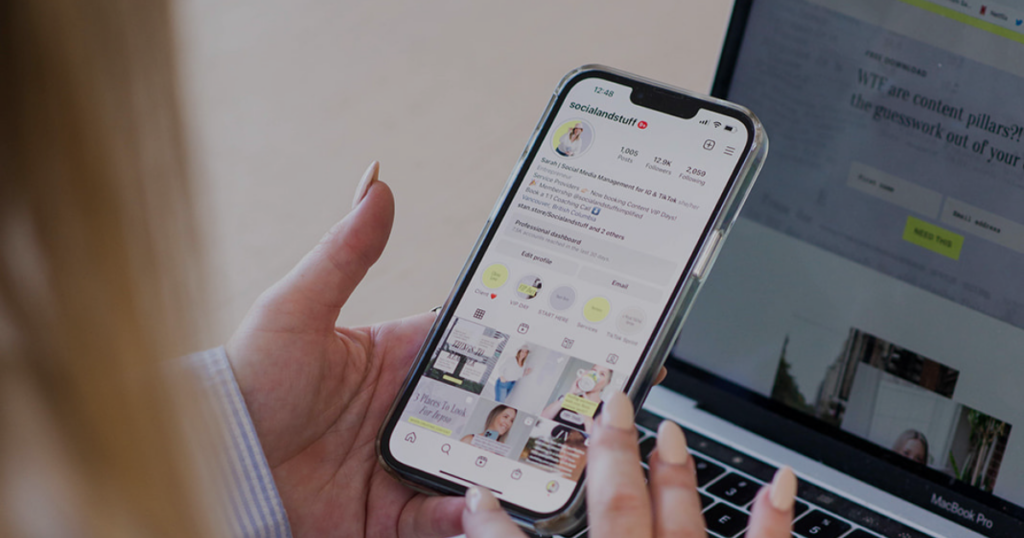Congrats! You want to promote / launch a new (or revamped) service or product, and you think Instagram is the ideal platform to use.
Having a focused week selling ONE thing not only creates brand awareness about your product or service, but it generally leads to sales or inquiries. It’s a solid boss move in business…But where do you even start when creating and launching a campaign on Instagram?

.Don’t worry; you’re completely in the right place! I’ve done this loads of times and have helped many other clients successfully navigate their own mini-campaign launches on Instagram. (You can take a lot of this info and use it on other platforms, but I’m specifically talking about Instagram in this blog.)
There are some awesome positives you achieve when you go through a launch, which include:
- You learn something new to take forward in your business
- You nail your messaging more clearly
- You become more comfortable talking about your offer
- You learn to create content around it and hone in on your sales skills
A launch is a win-win situation, so let’s dive in!

How often should you run a mini-campaign for promotion?
This one totally depends on your overall business goals and what season your business is in. But once a quarter is a great schedule to start with and stick to without being overwhelming.
How long does an Instagram mini-campaign last?
7-9 day ranges are common and liked by other small business owners because it gives enough time for your audience to see your offer a ton before they decide. When you consider how platforms like Instagram serve up your content to your audience, you don’t want to run your campaign for less than a week since not enough people may see it! I tested a 5-day pop-up campaign running for a week from Monday – Friday earlier this year, and I liked how quick and focused it was.
What about the lead-up to your mini-campaign?
This depends on where your current audience is at in their buyer journey. If they are super warm leads, you can create content that goes deeper into what you’re selling so they will be in the “take my money” headspace as soon as you launch. If you’ve been selling to the same audience for a year, spend your lead-up time creating growth content. Think top-of-funnel content for all those new eyeballs.
How much content should you post for your Instagram campaign?
You may not like the answer, but A LOT, lol! Like I said above, a lot of times, your audience doesn’t even see your content. To counteract that, try to post 2x a day during a launch. My go-to launch formula each day is 1 carousel post and 1 Reel (mainly a quick B-Roll with some direct-to-camera reels sprinkled in).
There is a caveat to this, though! All of your launch content is pretty much created ahead of time, and when you decide to launch the same service/product again, you can reuse the content with a few tweaks (e.x. Swap out the B-Roll, use the same concept in a new format, etc.).

For reference, when I did the 5-day pop-up mini-campaign (first time, too!) I rolled with a flexible schedule. Some days, I did 2 reels and other days, it was 1 reel and 1 carousel post. The next time I decide to run this pop-up again, I have something to start with, and that’s how you want to approach the process. The tweaks I will make in the future are to replace the B-Roll footage and trending audio, plus work in some direct-to-camera reels since I didn’t have any the first time. You can check out all the examples from that pop-up mini-campaign for inspo below!
DAY 1:
Reel: POV: You now save hours [problem your ideal is struggling with].
Image carousel w/ text: Woot woot! The doors are open… [share the bonus for this launch].
DAY 2:
Reel: POV: You start the week with [end result a.k.a. Deliverables].
Reel: Say bye-bye to [a negative thing your ideal client wants to get rid of].
DAY 3:
Reel: When you don’t know how to [what they need help with] and you step in!
Image carousel w/ text: Why I created [insert what you’re selling]…
DAY 4:
Reel: On my way to tell [ideal client] they can [solution they are after].
DAY 5:
Reel: B-Roll for a content series that ties in with your launch.

What type of content should you share for your promotion on Instagram?
You should include a mix of B-Roll, direct-to-camera, and some carousels to add variety, but the main takeaway is EVERYTHING relates to what you are selling. If you stay focused on that, you’ll feel less scattered or overwhelmed. This is where you want to lean into that problem-aware, transformation, and solution framework, no matter the content format.
Here’s an example for you that I’ve used before—POV: You now save hours in your day because you have a content strategy that does the heavy lifting, and no more crossing your fingers that your content works.
PRO TIP: Figure out your POV hooks, then pop them into Chat GPT to tighten up the messaging if you’re wordy like me. (Thank God for copywriting help!)
What type of CTA’s should I use?
You want your content to have a clear CTA, which could be to join a program or membership, to DM you for more info, join your email list, download a freebie or low-ticket digital product, sign up for a waitlist, etc. A common call-to-action strategy many small business owners are using is ManyChat. It’s effective because your CTA asks your audience to leave a comment with a specific word or emoji and that signals ManyChat to start the automation of the next step in your funnel. It means you don’t have to manually reply to every single comment or DM because the platform does it for you. Huge time saver!
I know that was A LOT of information to take in, so make sure you bookmark this blog post so you can go back and reference it for your next (or first!) Instagram mini-campaign launch. If we’re not friends on the ‘Gram yet, let’s connect there. You’ll do great and remember, I’m always here cheering you on!
Need help with getting your social media back on track before you launch? Check out this BLOG: Social Media 101: Get Your Socials Back on Track
Your Social BFF,
Sarah✌️



